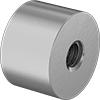Filter by
Thread Size
System of Measurement
Nut Type
Material
Thread Type
Threaded Insert Type
Thread Direction
Thread Spacing
DFARS Specialty Metals
Export Control Classification Number (ECCN)
Specifications Met
Travel Distance per Turn
Tensile Strength
Power Transmission
Fastening and Joining





























